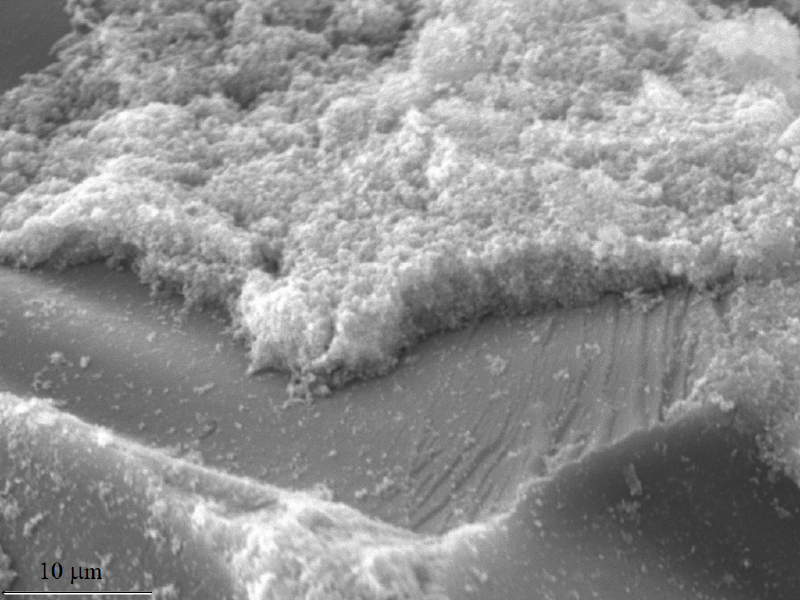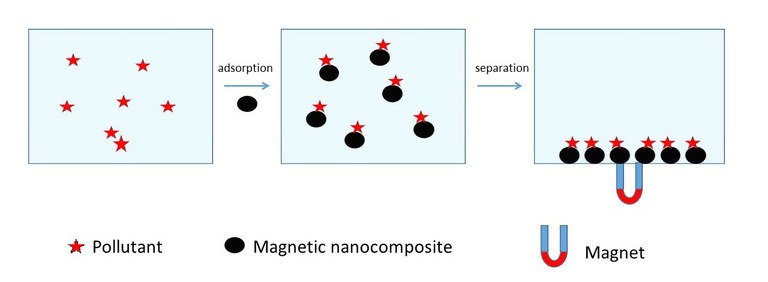Academy of Excellence "Space, Environment, Risk and Resilience"
Magnetic Nanoparticles for Environmental Applications and Risk Assessment: Towards a “Zero Waste Principle” Paradigm
An innovative approach for water depollution using magnetic nanocomposites.

Academy 3 highlight
This project addresses a critical environmental problem: the anthropogenic pollution related to organic and inorganic compounds released in the environment, especially water. It brings together physicists, chemists, and ecotoxicologists to develop and test new and innovative adsorbents for water depollution.
The project
Every year, huge quantities of organic and inorganic compounds are released in the environment as a consequence of human activities. Current water treatment technologies are designed for the removal of most metals, sulfates and phosphates but are not efficient regarding other classes of pollutants (such as organic pollutants, including pesticides or pharmaceutical compounds). As an alternative, we are investigating here a new process based on new materials: green hybrid composite materials made of biorefinery by-products and biopolymers. To these materials, we have added a magnetic iron oxide. The physical processes of removal are then, firstly, entrapment (adsorption) of the pollutant compounds onto the magnetic biobased nanocomposites, and secondly, recovery of the adsorbed pollutant by application of an external magnetic field; the later attracts and isolates the magnetic nanocomposite, and with it, the pollutant it carries. We chose dyes as models for hydrophilic organic pollutants and cesium as an example of radioactive pollutant (produced for instance in the Fukushima accident). Adsorption processes were studied as a function of parameters such as pH (i.e., acidity of the water), contact time between pollutant and composite surface, and initial concentration of pollutants.
Among the major results, the magnetization of biorefinery by-products and biopolymers has been successful. We could determine the optimal external magnetic field to be applied for a complete removal of the pollutants. Adsorption of pollutants was revealed to be dependent on pH (in range of 2-6) and on contact time. The adsorption process was found to operate even at low pollutant concentrations (lower than 10-4 mol/L). For example, 100% of the dye was removed after 24h, at pH 6. The use of magnetic biopolymer and biorefinery by-product nanocomposites might thus be a powerful way to depollute water at low cost and with minimal operational management.

The +
The project fits with both the green circular chemistry concept and the zero-waste principle. It brings together, for the first time, hybrid green materials and magnetic filtration to improve water treatment technology. This new approach should be valuable for pollution assessment and management.
What’s next?
If this project is successful, we will seek to produce biorefinery by-products with reinforced surface stability in an aqueous medium and enhanced adsorption properties. We will apply this process to other pollutants, including endocrine disruptors, and attempt to produce a pilot water treatment system (that could eventually result in a patent).
Project information
|
Scientific domain
Physics, Chemistry, Biology
Theme Environmental sciences
|
Key words
Water Depollution
Adsorption
Nanoparticles
Nanocomposites
Magnetic filtration
|
|
Total budget
60.2 k€ from Académie 3
|
Students inolved
Laurence Messina, (M1 P3M, UCA)
Jeanne Fèvre (M1 Chemistry, UCA)
Mathilde Schembri (BTS Chemistry, Lycée Thierry Maulnier, Nice)
Jordy Campos (M1 P3M, UCA)
Lingling Xiong (M1 Chimie, UCA)
Luna Checa Fernandez (M1, University of Granada)
Lucie Clapasson (BTS Chemistry, Lycée Thierry Maulnier, Nice)
|
| Partner laboratories
Institute of Chemistry of Nice (ICN), UMR 7272 UNS/CNRS
Laboratory ECOMERS (Ecology of Marine Ecosystems and Responses to Stress),
FRE 3729 UNS/CNRS Laboratory PHENIX (Physico-Chemistry of Electrolytes and Interfacial Nanosystems),
UMR 8234 Sorbonne Université/CNRS |
Project members
Charlotte Hurel,
Claire Lomenech,
Pavel Kuzhir,
Alain Ciffréo,
Alice Mija,
Hervé Michel,
Christine Risso-de Faverney,
Marielle Guibbolini-Sabater,
Agnès Bée,
Delphine Talbot.
|
Charlotte Hurel
INPHYNI, Université Côte d’Azur, CNRS
Project valorization
- Adsorption and magnetic filtration of pollutants by a biochar-based composite, C. Lomenech, Ch. Hurel, A. Mija, P. Kuzhir, M. Schembri, L. Messina, P. Tosi, A. Ciffréo, M. Guibbolini-Sabatier, Ch. Risso-de Faverney, A. Bée, D. Talbot, Ch. Den Auwer, H. Michel, IAP 2018, La Grande Motte, June 10-13, 2018
- A biochar-based nanocomposite for water depollution by adsorption and magnetic filtration, C. Lomenech, Ch. Hurel, A. Mija, P. Kuzhir, M. Schembri, L. Messina, P. Tosi, A. Ciffréo, M. Guibbolini-Sabatier, Ch. Risso-de Faverney, A. Bée, D. Talbot, Ch. Den Auwer, H. Michel , JSP 2018, Porquerolles, Septembre 10-12, 2018
- Acute toxicity assessment of magnetic iron nanoparticles and Biochar on living aquatic organisms, Daphnia magna, Guibbolini M., Bée A., Talbot D., Mija A., Hurel C., Lomenech C. & Risso-de Faverney C. , JSP 2018, Porquerolles, Septembre 10-12, 2018
- Removal of methylene blue by using combined magnetic nanoparticles and microfluidic channel, J. Campos, L. Checa-Fernandez, C. Lomenech, Ch. Hurel, A. Bée, D. Talbot & P. Kuzhir, JSP 2018, Porquerolles, Septembre 10-12, 2018
- Enhancing magnetic separation of nanoparticles by counter-ion adsorption: towards extraction of micro-pollutants from water, J. Campos, L. Checa-Fernandez, Ch. Hurel, C. Lomenech, A. Bée, D. Talbot & P. Kuzhir, Plenary Reunion GDR SLAMM, Hyères, November 12-15, 2018
- Enhancing microfluidic separation of magnetic nanoparticles by molecular adsorption, J. Campos, L. Checa-Fernandez, Ch. Hurel, C. Lomenech, A. Bée, D. Talbot & P. Kuzhir, ICMF 2019, Paris, July 8-12, 2019
- Elaboration et caractérisation d'un matériau à usage environnemental, Ch. Hurel, C. Lomenech, A. Mija, P. Kuzhir, 2èmes journées Matériaux UCA, Sophia Antipolis, 13 septembre 2019


















